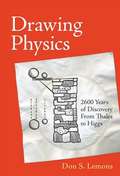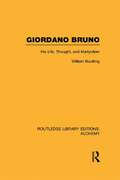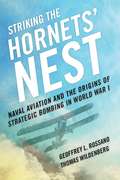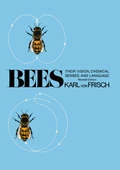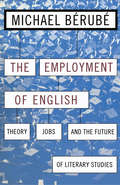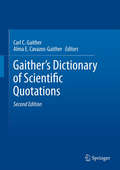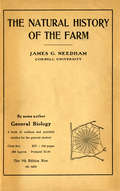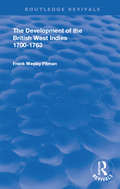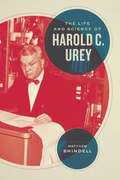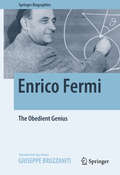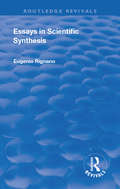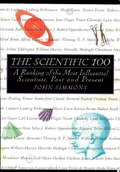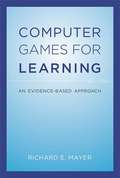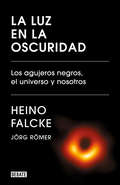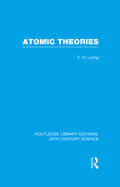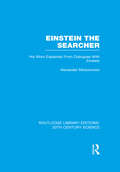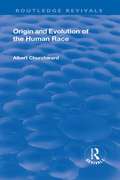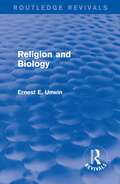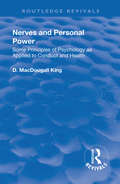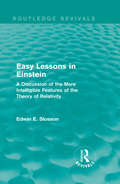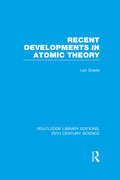- Table View
- List View
Drawing Physics: 2,600 Years of Discovery From Thales to Higgs
by Don S. LemonsHumans have been trying to understand the physical universe since antiquity. Aristotle had one vision (the realm of the celestial spheres is perfect), and Einstein another (all motion is relativistic). More often than not, these different understandings begin with a simple drawing, a pre-mathematical picture of reality. Such drawings are a humble but effective tool of the physicist's craft, part of the tradition of thinking, teaching, and learning passed down through the centuries. This book uses drawings to help explain fifty-one key ideas of physics accessibly and engagingly. Don Lemons, a professor of physics and author of several physics books, pairs short, elegantly written essays with simple drawings that together convey important concepts from the history of physical science.Lemons proceeds chronologically, beginning with Thales' discovery of triangulation, the Pythagorean monocord, and Archimedes' explanation of balance. He continues through Leonardo's description of "earthshine" (the ghostly glow between the horns of a crescent moon), Kepler's laws of planetary motion, and Newton's cradle (suspended steel balls demonstrating by their collisions that for every action there is always an equal and opposite reaction). Reaching the twentieth and twenty-first centuries, Lemons explains the photoelectric effect, the hydrogen atom, general relativity, the global greenhouse effect, Higgs boson, and more. The essays place the science of the drawings in historical context -- describing, for example, Galileo's conflict with the Roman Catholic Church over his teaching that the sun is the center of the universe, the link between the discovery of electrical phenomena and the romanticism of William Wordsworth, and the shadow cast by the Great War over Einstein's discovery of relativity. Readers of Drawing Physics with little background in mathematics or physics will say, "Now I see, and now I understand."
Giordano Bruno: His Life, Thought, and Martyrdom (Routledge Library Editions: Alchemy)
by William BoultingThis comprehensive book outlines the life and works of an important revolutionary intellectual of the 16th Century. This book follows Bruno’s life and the development of his thought in the order in which he declared it. Giordano Bruno was an Italian Dominican friar, philosopher, mathematician and astronomer. He was burned at the stake after the Roman Inquisition found him guilty of heresy but his modern scientific thought and cosmology became very influential. His writings on science also showed interest in magic and alchemy and those are outlined in this book alongside what he is most remembered for - his place in the history of the relationship between science and faith.
Striking The Hornets' Nest: Naval Aviation And The Origins Of Strategic Bombing In World War I
by Thomas Wildenberg Geoffrey L. RossanoStriking the Hornets’ Nest provides the first extensive analysis of the Northern Bombing Group (NBG), the Navy’s most innovative aviation initiative of World War I and one of the world’s first dedicated strategic bombing programs. Very little has been written about the Navy’s aviation activities in World War I and even less on the NBG. Standard studies of strategic bombing tend to focus on developments in the Royal Air Force or the U. S. Army Air Service. This work concentrates on the origins of strategic bombing in World War I, and the influence this phenomenon had on the Navy’s future use of the airplane. The NBG program faced enormous logistical and personnel challenges. Demands for aircraft, facilities, and personnel were daunting, and shipping shortages added to the seemingly endless delays in implementing the program. Despite the impediments, the Navy (and Marine Corps) triumphed over organizational hurdles and established a series of bases and depots in northern France and southern England in the late summer and early fall of 1918. Ironically, by the time the Navy was ready to commence bombing missions, the German retreat had caused abandonment of the submarine bases the NBG had been created to attack. The men involved in this program were pioneers, overcoming major obstacles only to find they were no longer needed. Though the Navy rapidly abandoned its use of strategic bombing after World War I, their brief experimentation directed the future use of aircraft in other branches of the armed forces. It is no coincidence that Robert Lovett, the young Navy reserve officer who developed much of the NBG program in 1918, spent the entire period of World War II as Assistant Secretary of War for Air where he played a crucial role organizing and equipping the strategic bombing campaign unleashed against Germany and Japan. Rossano and Wildenberg have provided a definitive study of the NBG, a subject that has been overlooked for too long.
Bees: Their Vision, Chemical Senses, and Language
by Karl Von Frisch Donald R GriffinOver half a century of brilliant scientific detective work, the Nobel Prize-winning biologist Karl von Frisch learned how the world, looks, smells, and tastes to a bee. More significantly, he discovered their dance language and their ability to use the sun as a compass. Intended to serve as an accessible introduction to one of the most fascinating areas of biology, Bees (first published in 1950 and revised in 1971), reported the startling results of his ingenious and revolutionary experiments with honeybees.In his revisions, von Frisch updated his discussion about the phylogenetic origin of the language of bees and also demonstrated that their color sense is greater than had been thought previously. He also took into consideration the electrophysiological experiments and electromicroscopic observations that have supplied more information on how the bee analyzes polarized light to orient itself and how the olfactory organs on the bee's antennae function.Now back in print after more than two decades, this classic and still-accurate account of the behavior patterns and sensory capacities of the honeybee remains a book "written with a simplicity, directness, and charm which all who know him will recognize as characteristic of its author. Any intelligent reader, without scientific training, can enjoy it."--Yale Review
Employment of English: Theory, Jobs, and the Future of Literary Studies (Cultural Front #13)
by Michael BérubéWhat sorts of cultural criticism are teachers and scholars to produce, and how can that criticism be "employed" in the culture at large? In recent years, debates about the role and direction of English departments have mushroomed into a broader controversy over the public legitimacy of literary criticism. At first glance this might seem odd: few taxpayers and legislators care whether the nation's English professors are doing justice to the project of identifying the beautiful and the sublime. But in the context of the legitimation crisis in American higher education, the image of English departments has in fact played a major role in determining public attitudes toward colleges and college faculty. Similarly, the changing economic conditions of universities have prompted many English professors to rethink their relations to their "clients," asking how literary study can serve the American public. What sorts of cultural criticism are teachers and scholars to produce, and how can that criticism be "employed" in the culture at large? In The Employment of English, Michael Bérubé, one of our most eloquent and gifted critics, examines the cultural legitimacy of literary study. In witty, engaging prose, Bérubé asserts that we must situate these questions in a context in which nearly half of all college professors are part-time labor and in which English departments are torn between their traditional mission of defining movements of literary history and protocols of textual interpretation, and their newer tasks of interrogating wider systems of signification under rubrics like "gender," "hegemony," "rhetoric," "textuality" (including film and video), and "culture." Are these new roles a betrayal of the field's founding principles, in effect a short-sighted sell-out of the discipline? Do they represent little more that an attempt to shore up the status of--and student enrollments in--English? Or are they legitimate objects of literary study, in need of public support? Simultaneously investigating the economic and the intellectual ramifications of current debates, The Employment of English provides the clearest and most condensed account of this controversy to date.
Gaither's Dictionary of Scientific Quotations
by Carl C. Gaither Alma E. Cavazos-GaitherThis unprecedented collection of 27,000 quotations is the most comprehensive and carefully researched of its kind, covering all fields of science and mathematics. With this vast compendium you can readily conceptualize and embrace the written images of scientists, laymen, politicians, novelists, playwrights, and poets about humankind's scientific achievements. Approximately 9000 high-quality entries have been added to this new edition to provide a rich selection of quotations for the student, the educator, and the scientist who would like to introduce a presentation with a relevant quotation that provides perspective and historical background on his subject. Gaither's Dictionary of Scientific Quotations, Second Edition, provides the finest reference source of science quotations for all audiences. The new edition adds greater depth to the number of quotations in the various thematic arrangements and also provides new thematic categories.
Informing the Future: Critical Issues in Health, Sixth Edition
by Institute of MedicineThis report illustrates the work of IOM committees in selected, major areas in recent years, followed by a description of IOM's convening and collaborative activities and fellowship programs. The last section provides a comprehensive bibliography of IOM reports published since 2007.
Natural History of the Farm: A Guide to the Practical Study of the Sources of Our Living in Wild Nature
by James G. NeedhamThis is a guide to the practical study of the sources in wild nature of our living. It contains a series of study outlines for the entire year, and deals with both the plants and animals of the farm-the things that men have chosen to deal with as a means of livelihood and of personal satisfaction in all ages.
Report of the Committee on Proposal Evaluation for Allocation of Supercomputing Time for the Study of Molecular Dynamics: Second Round
by Board on Life SciencesThe Committee on Proposal Evaluation for Allocation of Supercomputing Time for the Study of Molecular Dynamics evaluated submissions received in response to a Request for Proposals (RFP) for Biomolecular Simulation Time on Anton, a supercomputer specially designed and built by D.E. Shaw Research (DESRES) that allows for dramatically increased molecular dynamics simulations compared to other currently available resources. Over the past year (October 1, 2010 -- September 30, 2011), DESRES has made available to the non-commercial research community 3,000,000 node-hours on an Anton system housed at the Pittsburgh Supercomputing Center (PSC), based on the advice of a previous National Research Council committee convened in the fall of 2010. The goal of the second RFP for Biomolecular Simulation Time on Anton has been to continue to facilitate breakthrough research in the study of biomolecular systems by providing a massively parallel system specially designed for molecular dynamics simulations. These special capabilities allow multi-microsecond to millisecond simulation timescales, which previously had been unobtainable. The program seeks to continue to support research that addresses important and high impact questions demonstrating a clear need for Anton's special capabilities. The Anton RFP described the three criteria against which the committee was asked to evaluate proposals: Scientific Merit, Justification for Requested Time Allocation, and Investigator Qualifications and Past Accomplishments.
The Development of the British West Indies: 1700-1763 (Routledge Revivals)
by Frank Wesley PitmanOriginally published in 1917, this book is an investigation of industrial and social conditions in the British West Indies in the effort to reach a better understandinf of the part those islands played in the growth and dissolution of the British empire, including chapters on white labor in the sugar islands, the slave trade, and foreign markets for British sugar.
The Life and Science of Harold C. Urey (Synthesis)
by Matthew ShindellHarold C. Urey (1893–1981), whose discoveries lie at the foundation of modern science, was one of the most famous American scientists of the twentieth century. Born in rural Indiana, his evolution from small-town farm boy to scientific celebrity made him a symbol and spokesman for American scientific authority. Because he rose to fame alongside the prestige of American science, the story of his life reflects broader changes in the social and intellectual landscape of twentieth-century America. In this, the first ever biography of the chemist, Matthew Shindell shines new light on Urey’s struggles and achievements in a thoughtful exploration of the science, politics, and society of the Cold War era. From Urey’s orthodox religious upbringing to his death in 1981, Shindell follows the scientist through nearly a century of American history: his discovery of deuterium and heavy water earned him the Nobel Prize in 1934, his work on the Manhattan Project helped usher in the atomic age, he initiated a generation of American scientists into the world of quantum physics and chemistry, and he took on the origin of the Moon in NASA’s lunar exploration program. Despite his success, however, Urey had difficulty navigating the nuclear age. In later years he lived in the shadow of the bomb he helped create, plagued by the uncertainties unleashed by the rise of American science and unable to reconcile the consequences of scientific progress with the morality of religion. Tracing Urey’s life through two world wars and the Cold War not only conveys the complex historical relationship between science and religion in the twentieth century, but it also illustrates how these complexities spilled over into the early days of space science. More than a life story, this book immerses readers in the trials and triumphs of an extraordinary man and his extraordinary times.
Enrico Fermi
by Giuseppe BruzzanitiThis biography explores the life and career of the Italian physicist Enrico Fermi, which is also the story of thirty years that transformed physics and forever changed our understanding of matter and the universe: nuclear physics and elementary particle physics were born, nuclear fission was discovered, the Manhattan Project was developed, the atomic bombs were dropped, and the era of "big science" began. It would be impossible to capture the full essence of this revolutionary period without first understanding Fermi, without whom it would not have been possible. Enrico Fermi: The Obedient Genius attempts to shed light on all aspects of Fermi's life - his work, motivation, influences, achievements, and personal thoughts - beginning with the publication of his first paper in 1921 through his death in 1954. During this time, Fermi demonstrated that he was indeed following in the footsteps of Galileo, excelling in his work both theoretically and experimentally by deepening our understanding of the Pauli exclusion principle, winning the Nobel Prize for his discovery of the fundamental properties of slow neutrons, developing the theory of beta decay, building the first nuclear reactor, and playing a central role in the development of the atomic bomb. Interwoven with this fascinating story, the book details the major developments in physics and provides the necessary background material to fully appreciate the dramatic changes that were taking place. Also included are appendices that provide a timeline of Fermi's life, several primary source documents from the period, and an extensive bibliography. This book will enlighten anyone interested in Fermi's work or the scientific events that led to the physics revolution of the first half of the twentieth century.
Revival: Essays in Scientific Synthesis (Routledge Revivals)
by Eugenio RignanoAlthough each of the essays in this volume is a study complete in itself, they are connected by one and the same synthetic spirit, and are animated by one and the same object: that of demonstrating the utility in the biological, psychological, and sociological fields of the theorist, who, without having specialized in any particular branch or subdivision of science, may nevertheless bring into those spheres that synthetic and unifying vision which is brought by the theorist mathematician, with so much success, into the physico-chemical field of science.
A Mathematician's Apology
by G. H. HardyG. H. Hardy was one of this century's finest mathematical thinkers, renowned among his contemporaries as a 'real mathematician … the purest of the pure'. He was also, as C. P. Snow recounts in his Foreword, 'unorthodox, eccentric, radical, ready to talk about anything'. This 'apology', written in 1940, offers a brilliant and engaging account of mathematics as very much more than a science; when it was first published, Graham Greene hailed it alongside Henry James's notebooks as 'the best account of what it was like to be a creative artist'. C. P. Snow's Foreword gives sympathetic and witty insights into Hardy's life, with its rich store of anecdotes concerning his collaboration with the brilliant Indian mathematician Ramanujan, his idiosyncrasies and his passion for cricket. This is a unique account of the fascination of mathematics and of one of its most compelling exponents in modern times.
The Scientific 100
by John Lynda SimmonsWho are the great scientists throughout the ages, and what exactly did they do to earn their importance? From Archimedes to Newton to Einstein to Hawking, The Scientific 100 provides the fascinating answers. Vivid biographical sketches chronicle the lives and accomplishments of the world's preeminent scientists. And in the tradition of the Citadel Press 100 Series, they are ranked provocatively in order of influence--an inspiration for lively discussion. This unique volume is a browser's treasure trove and a handy reference for the general reader. John Simmons has been associated with Current Biography for more than fifteen years. He has written frequently about Nobel laureates in science. A member of the New York Academy of Sciences, he divides his time between New York City and Paris.
Computer Games for Learning
by Richard E. MayerMany strong claims are made for the educational value of computer games, but there is a need for systematic examination of the research evidence that might support such claims. This book fills that need by providing, a comprehensive and up-to-date investigation of what research shows about learning with computer games. Computer Games for Learning describes three genres of game research: the value-added approach, which compares the learning outcomes of students who learn with a base version of a game to those of students who learn with the base version plus an additional feature; the cognitive consequences approach, which compares learning outcomes of students who play an off-the-shelf computer game for extended periods to those of students who do not; and the media comparative approach, which compares the learning outcomes of students who learn material by playing a game to those of students who learn the same material using conventional media. After introductory chapters that describe the rationale and goals of learning game research as well as the relevance of cognitive science to learning with games, the book offers examples of research in all three genres conducted by the author and his colleagues at the University of California, Santa Barbara; meta-analyses of published research; and suggestions for future research in the field. The book is essential reading for researchers and students of educational games, instructional designers, learning-game developers, and anyone who wants to know what the research has to say about the educational effectiveness of computer games.
La luz en la oscuridad: Los agujeros negros, el universo y nosotros
by Heino FalckeUn viaje extraordinario a los límites del tiempo, el espacio y la mente humana, de la mano de Heino Falcke, galardonado con la Medalla Henry Draper 2021. El 10 de abril de 2019 un equipo internacional de astrónomos liderados por el profesor Heino Falcke maravilló al mundo publicando la primera imagen de un agujero negro. Por fin la comunidad científica conseguía la prueba irrefutable de lo que Einstein había predicho en su teoría de la relatividad acerca de estos fenómenos hacía más de cien años. Sin embargo, las implicaciones de este hallazgo van más allá: si bien son objetos relativamente simples de definir, los agujeros negros plantean algunos de los interrogantes más complejos sobre la naturaleza del espacio, del tiempo, y, por último, de nuestra existencia. En este libro, Falcke no solo nos narra la emocionante historia de esta proeza científica, sino que da un paso más intentando responder a las grandes preguntas filosóficas que este hito plantea: ¿existe algo más allá de la nada?, ¿puede la ciencia explicar lo inexplicable?, ¿cuál es el origen de nuestra existencia y qué sentido tiene nuestro paso por el mundo? Para Heino Falcke, la astrofísica y la metafísica, la razón y la fe, no tienen por qué excluirse mutuamente. La luz en la oscuridad es un poderoso alegato a favor de la ciencia que nos habla de lo que sabemos pero también de los misterios que quedan por resolver.
Atomic Theories (Routledge Library Editions: 20th Century Science)
by F.H. LoringSummarising the most novel facts and theories which were coming into prominence at the time, particularly those which had not yet been incorporated into standard textbooks, this important work was first published in 1921. The subjects treated cover a wide range of research that was being conducted into the atom, and include Quantum Theory, the Bohr Theory, the Sommerfield extension of Bohr’s work, the Octet Theory and Isotopes, as well as Ionisation Potentials and Solar Phenomena. Because much of the material of Atomic Theories lies on the boundary between experimentally verified fact and speculative theory, it indicates in a unique way how the future of physics was perceived at the time of writing. It thus throws into stark relief not only the immense advances made since the 1920s, but also, perhaps, highlights the importance of not rigidly adhering to a particular program of future discoveries.
Einstein The Searcher: His Work Explained from Dialogues with Einstein (Routledge Library Editions: 20th Century Science)
by Alexander MoszkowskiThis volume, first published in 1921, presents a series of portraits of Einstein, thus offering glimpses in the character and private reflections of the man who changed the course of modern science. Intended neither as a biography, nor as a résumé of Einsteinian physics, Einstein: The Searcher instead focusses on Einstein’s relationship with the scientific project as he himself conceived it, and so is still of contemporary significance for those puzzled by the spirit of scientific enquiry.
Revival: Connected With The Origin And Evolution Of The Human Race (Routledge Revivals)
by Albert ChurchwoodWhere and when did man make his first appearance on this earth? The object of this book is to bring before the public such further facts and values regarding the evolution of man. After studies Churchwood made during many years, he is now fully convinced that the hitherto preconceived ideas of many scientists regarding the origin of the human race, both as to place and date, are erroneous, and evidence will be brought forward to prove that the human race did not originate in Asia, but in Africa.
Religion and Biology
by Ernest E. UnwinFirst published in 1922, this book represents an attempt to outline the biological approach to the questions of religious thought. The author posits the book as a contribution to religious thought in relation to the purpose of God in Nature, providing readers with an overview of the advances and changes in thought that had occurred in the years before the book was written. The examinations of the nature of man and of evolution in relation to religion make up the bulk of the book along with a look at the argument from beauty. The book will be of interest to students of religion, biology and philosophy.
Revival: Some Principles of Psychology as Applied to Conduct and Personal Power (Routledge Revivals)
by D. MacDougall KingThe aim of this treatise is to give the public a much needed understanding of those factors in everyday living which on the one hand tend toward nervous weakness, and on the other make for personal power. From the author’s viewpoint, everybody at times suffers from symptoms which are popularly termed "nervous," for nervousness is a matter of degree rather than kind. Whether "nerves" take the form of unreasonable impulsiveness or of serious obsessions occasioning body pain, the fundamental cause and radical cure of both are essentially the same.
Routledge Revivals: A Discussion of the More Intelligible Features of the Theory of Relativity (Routledge Revivals)
by Edwin E. SlossonFirst published in 1922, this book represents the first attempt to popularise the more accessible aspects of Albert Einstein’s general theory of relativity. Eschewing the mathematical components that put the theory beyond many people’s grasp, the author employs metaphorical examples and thought experiments to convey the fundamental ideas and assertions of one of physics’ most famous principles — which remains the accepted description of gravitation more than a century after its first publication. This book will of interest to students of physics as an introductory basis to aid further study.
Radio-Mastery of the Ether (The Story Of Modern Science, Vol. IX)
by Henry Smith WilliamsThis book describes the beginnings of radio - the mystery of unseen waves and the people experimenting with this new process. The book was handed down to me by my Grandfather who served in the Spanish-American War and then settled in San Francisco in 1905; just in time for the earthquake. The last few pages are ads complete with 1923 prices. One is for a book - Sergeant York and His People- later Gary Cooper stared in the movie - Sergeant York.
Recent Developments in Atomic Theory (Routledge Library Editions: 20th Century Science)
by Leo GraetzInto the short compass of this book Professor Graetz has succeeded in compressing an eminently readable survey of the directions in which the atomic theory, as accepted in the nineteenth century, has been extended by the remarkable and almost revolutionary physical investigations and discoveries of the two decades preceding the book’s original publication in 1923.
